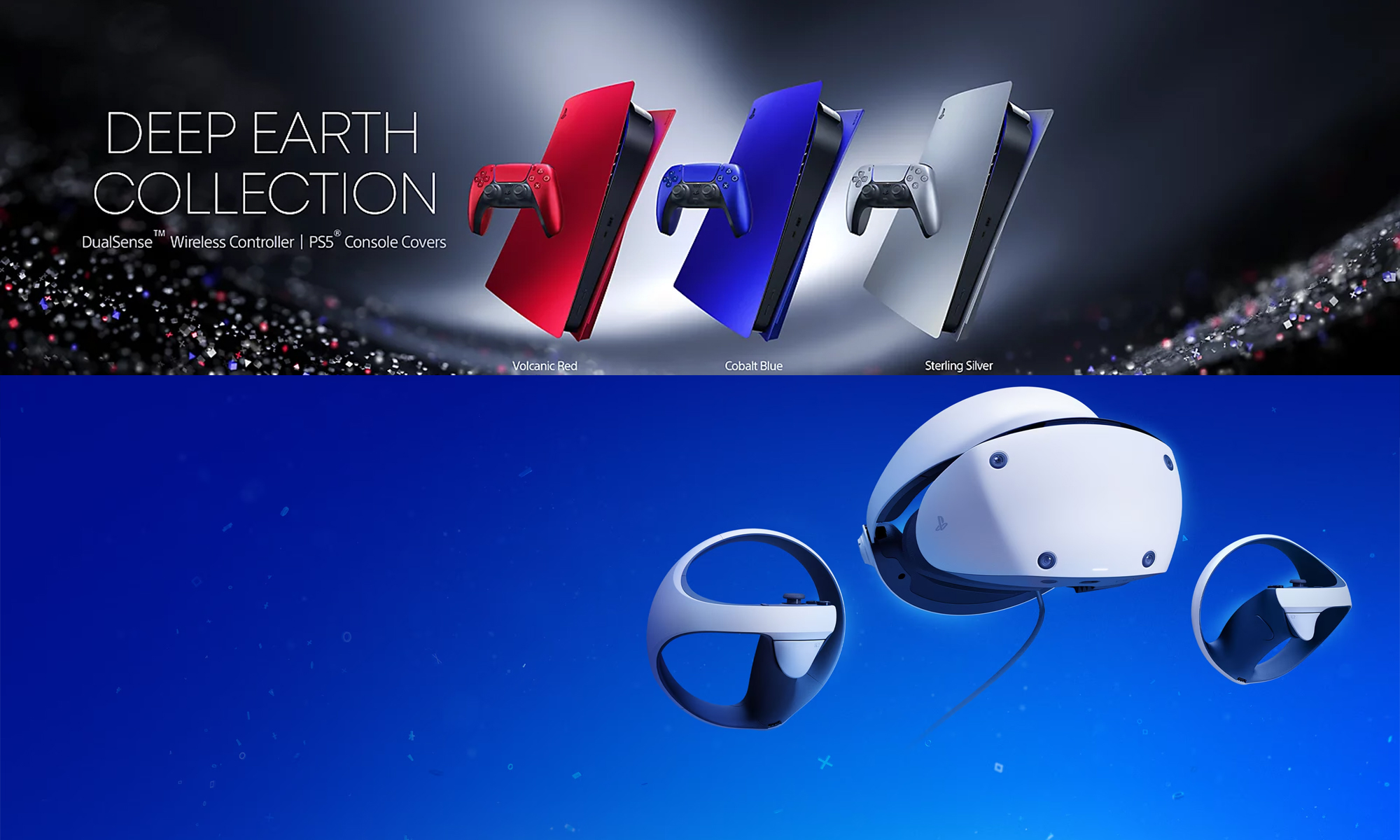Highway theme by CGJ
Download: Highway.p3t
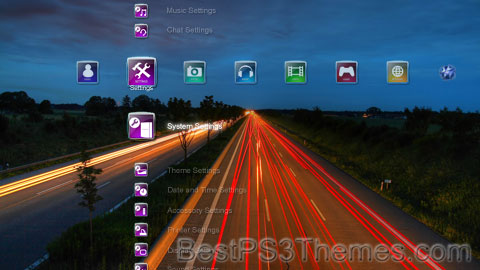
(1 background, different for HD and SD)


A highway is any public or private road or other public way on land. It includes not just major roads, but also other public roads and rights of way. In the United States, it is also used as an equivalent term to controlled-access highway, or a translation for motorway, Autobahn, autostrada, autoroute, etc.[1]
According to Merriam-Webster, the use of the term predates the 12th century. According to Etymonline, "high" is in the sense of "main".
In North American and Australian English, major roads such as controlled-access highways or arterial roads are often state highways (Canada: provincial highways). Other roads may be designated "county highways" in the US and Ontario. These classifications refer to the level of government (state, provincial, county) that maintains the roadway. In British English, "highway" is primarily a legal term. Everyday use normally implies roads, while the legal use covers any route or path with a public right of access, including footpaths etc.
The term has led to several related derived terms, including highway system, highway code, highway patrol and highwayman.
Overview[edit]
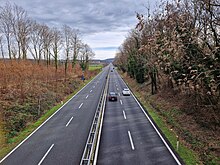
Major highways are often named and numbered by the governments that typically develop and maintain them. Australia's Highway 1 is the longest national highway in the world at over 14,500 kilometres (9,000 mi) and runs almost the entire way around the continent. China has the world's largest network of highways, followed closely by the United States. Some highways, like the Pan-American Highway or the European routes, span multiple countries. Some major highway routes include ferry services, such as US Route 10, which crosses Lake Michigan.
Traditionally highways were used by people on foot or on horses. Later they also accommodated carriages, bicycles and eventually motor cars, facilitated by advancements in road construction. In the 1920s and 1930s, many nations began investing heavily in highway systems in an effort to spur commerce and bolster national defence.
Major highways that connect cities in populous developed and developing countries usually incorporate features intended to enhance the road's capacity, efficiency, and safety to various degrees. Such features include a reduction in the number of locations for user access, the use of dual carriageways with two or more lanes on each carriageway, and grade-separated junctions with other roads and modes of transport. These features are typically present on highways built as motorways (freeways).
Terminology[edit]
England and Wales[edit]
The general legal definition deals with right of use, not the form of construction; this is distinct from e.g. the popular use of the word in the US. A highway is defined in English common law by a number of similarly worded definitions such as "a way over which all members of the public have the right to pass and repass without hindrance"[2] usually accompanied by "at all times"; ownership of the ground is for most purposes irrelevant, thus the term encompasses all such ways from the widest trunk roads in public ownership to the narrowest footpath providing unlimited pedestrian access over private land.
A highway might be open to all forms of lawful land traffic (e.g. vehicular, horse, pedestrian) or limited to specific modes of traffic; usually a highway available to vehicles is also available to foot or horse traffic, a highway available to horse traffic is available to cyclists and pedestrians; but there are exceptional cases in which a highway is only available to vehicles, or is subdivided into dedicated parallel sections for different users.
A highway can share ground with a private right of way for which full use is not available to the general public: for example farm roads which the owner may use for any purpose but for which the general public only has a right of use on foot or horseback. The status of highway on most older roads has been gained by established public use, while newer roads are typically dedicated as highways from the time they are adopted (taken into the care and control of a council or other public authority). In England and Wales, a public highway is also known as "The King's Highway".[3]
The core definition of a highway is modified in various legislation for a number of purposes but only for the specific matters dealt with in each such piece of legislation. This is typically in the case of bridges, tunnels and other structures whose ownership, mode of use or availability would otherwise exclude them from the general definition of a highway. Recent examples include toll bridges and tunnels which have the definition of highway imposed upon them (in a legal order applying only to the individual structure) to allow application of most traffic laws to those using them but without causing all of the general obligations or rights of use otherwise applicable to a highway.
Limited access highways for vehicles, with their own traffic rules, are called "motorways" in the UK.[4]
Scotland[edit]
Scots law is similar to English law with regard to highways but with differing terminology and legislation. What is defined in England as a highway will often in Scotland be what is defined by s.151 Roads (Scotland) Act 1984 (but only "in this act" although other legislation could imitate) simply as a road, that is:
- "any way (other than a waterway) over which there is a public right of passage (by whatever means [and whether subject to a toll or not]) and includes the road’s verge, and any bridge (whether permanent or temporary) over which, or tunnel through which, the road passes; and any reference to a road includes a part thereof"
The word highway is itself no longer a statutory expression in Scots law[5] but remains in common law.
United States[edit]

In American law, the word "highway" is sometimes used to denote any public way used for travel, whether a "road, street, and parkway";[6] however, in practical and useful meaning, a "highway" is a major and significant, well-constructed road that is capable of carrying reasonably heavy to extremely heavy traffic.[7] Highways generally have a route number designated by the state and federal departments of transportation.[clarification needed]
California Vehicle Code, Sections 360, 590, define a "highway" as only a way open for use by motor vehicles, but the California Supreme Court has held that "the definition of 'highway' in the Vehicle Code is used for special purposes of that act" and that canals of the Los Angeles neighborhood of Venice are "highways" that are entitled to be maintained with state highway funds.[8]
History[edit]

Large scale highway systems developed in the 20th century as automobile usage increased. The first United States limited-access road was constructed on Long Island, New York, and known as the Long Island Motor Parkway or the Vanderbilt Motor Parkway. It was completed in 1911.[11] It included many modern features, including banked turns, guard rails and reinforced concrete tarmac.[12] Traffic could turn left between the parkway and connectors, crossing oncoming traffic, so it was not a controlled-access highway (or "freeway" as later defined by the federal government's Manual on Uniform Traffic Control Devices).
Italy was the first country in the world to build controlled-access highways reserved for fast traffic and for motor vehicles only.[9][10] The Autostrada dei Laghi ("Lakes Highway"), the first built in the world, connecting Milan to Lake Como and Lake Maggiore, and now parts of the A8 and A9 highways, was devised by Piero Puricelli and was inaugurated in 1924.[10] This highway, called autostrada, contained only one lane in each direction and no interchanges.
The Southern State Parkway opened in 1927, while the Long Island Motor Parkway was closed in 1937 and replaced by the Northern State Parkway (opened 1931) and the contiguous Grand Central Parkway (opened 1936). In Germany, construction of the Bonn-Cologne Autobahn began in 1929 and was opened in 1932 by Konrad Adenauer, then the mayor of Cologne.[13]
In the US, the Federal Aid Highway Act of 1921 (Phipps Act) enacted a fund to create an extensive highway system. In 1922, the first blueprint for a national highway system (the Pershing Map) was published. The Federal Aid Highway Act of 1956 allocated $25 billion for the construction of the 66,000-kilometre-long (41,000 mi) Interstate Highway System over a 20-year period.[14]
In Great Britain, the Special Roads Act 1949 provided the legislative basis for roads for restricted classes of vehicles and non-standard or no speed limits applied (later mostly termed motorways but now with speed limits not exceeding 70 mph);[15] in terms of general road law this legislation overturned the usual principle that a road available to vehicular traffic was also available to horse or pedestrian traffic as is usually the only practical change when non-motorways are reclassified as special roads. The first section of motorway in the UK opened in 1958 (part of the M6 motorway) and then in 1959 the first section of the M1 motorway.[16]
Social effects[edit]

Often reducing travel times relative to city or town streets, highways with limited access and grade separation can create increased opportunities for people to travel for business, trade or pleasure and also provide trade routes for goods. Highways can reduce commute and other travel time but additional road capacity can also release latent traffic demand. If not accurately predicted at the planning stage, this extra traffic may lead to the new road becoming congested sooner than would otherwise be anticipated by considering increases in vehicle ownership. More roads allow drivers to use their cars when otherwise alternatives may have been sought, or the journey may not have been made, which can mean that a new road brings only short-term mitigation of traffic congestion.

Where highways are created through existing communities, there can be reduced community cohesion and more difficult local access. Consequently, property values have decreased in many cutoff neighborhoods, leading to decreased housing quality over time. Mostly in the U.S., many of these effects are from racist planning practices from before the advent of civil rights. This would result in the vast majority of displacement and social effects mostly going to people like African Americans.[19]
In recent times, the use of freeway removal or the public policy of urban planning to demolish freeways and create mixed-use urban areas, parks, residential, commercial, or other land uses is being popular in many cities to combat most of the social problems caused from highways.[20]
Economic effects[edit]
In transport, demand can be measured in numbers of journeys made or in total distance travelled across all journeys (e.g. passenger-kilometres for public transport or vehicle-kilometres of travel (VKT) for private transport). Supply is considered to be a measure of capacity. The price of the good (travel) is measured using the generalised cost of travel, which includes both money and time expenditure.

The effect of increases in supply (capacity) are of particular interest in transport economics (see induced demand), as the potential environmental consequences are significant (see externalities below).
In addition to providing benefits to their users, transport networks impose both positive and negative externalities on non-users. The consideration of these externalities—particularly the negative ones—is a part of transport economics. Positive externalities of transport networks may include the ability to provide emergency services, increases in land value and agglomeration benefits. Negative externalities are wide-ranging and may include local air pollution, noise pollution, light pollution, safety hazards, community severance and congestion. The contribution of transport systems to potentially hazardous climate change is a significant negative externality which is difficult to evaluate quantitatively, making it difficult (but not impossible) to include in transport economics-based research and analysis. Congestion is considered a negative externality by economists.[21]
A 2016 study found that for the United States, "a 10% increase in a region's stock of highways causes a 1.7% increase in regional patenting over a five-year period."[22] A 2021 study found that areas that obtained access to a new highway experienced a substantial increase in top-income taxpayers and a decline in low-income taxpayers. Highways also contributed to job and residential urban sprawl.[23]
Environmental effects[edit]

Highways are extended linear sources of pollution.
Roadway noise increases with operating speed so major highways generate more noise than arterial streets. Therefore, considerable noise health effects are expected from highway systems. Noise mitigation strategies exist to reduce sound levels at nearby sensitive receptors. The idea that highway design could be influenced by acoustical engineering considerations first arose about 1973.[24][25]
Air quality issues: Highways may contribute fewer emissions than arterials carrying the same vehicle volumes. This is because high, constant-speed operation creates an emissions reduction compared to vehicular flows with stops and starts. However, concentrations of air pollutants near highways may be higher due to increased traffic volumes. Therefore, the risk of exposure to elevated levels of air pollutants from a highway may be considerable, and further magnified when highways have traffic congestion.
New highways can also cause habitat fragmentation, encourage urban sprawl and allow human intrusion into previously untouched areas, as well as (counterintuitively) increasing congestion, by increasing the number of intersections.
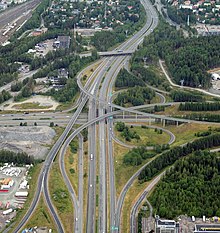
They can also reduce the use of public transport, indirectly leading to greater pollution.
High-occupancy vehicle lanes are being added to some newer/reconstructed highways in the United States and other countries around the world to encourage carpooling and mass transit. These lanes help reduce the number of cars on the highway and thus reduces pollution and traffic congestion by promoting the use of carpooling in order to be able to use these lanes. However, they tend to require dedicated lanes on a highway, which makes them difficult to construct in dense urban areas where they are the most effective.
To address habitat fragmentation, wildlife crossings have become increasingly popular in many countries. Wildlife crossings allow animals to safely cross human-made barriers like highways.[26]
Road traffic safety[edit]
Road traffic safety describes the safety performance of roads and streets, and methods used to reduce the harm (deaths, injuries, and property damage) on the highway system from traffic collisions. It includes the design, construction and regulation of the roads, the vehicles used on them and the training of drivers and other road-users.
A report published by the World Health Organization in 2004 estimated that some 1.2 million people were killed and 50 million injured on the roads around the world each year[27] and was the leading cause of death among children 10–19 years of age.
The report also noted that the problem was most severe in developing countries and that simple prevention measures could halve the number of deaths.[28] For reasons of clear data collection, only harm involving a road vehicle is included.[29] A person tripping with fatal consequences or dying for some unrelated reason on a public road is not included in the relevant statistics.
Statistics[edit]


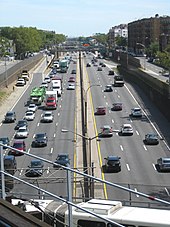
The United States has the world's largest network of highways, including both the Interstate Highway System and the United States Numbered Highway System. At least one of these networks is present in every state and they interconnect most major cities. It is also the world's most expensive mega-project,[30] as the entirety of the Interstate Highway System was estimated to cost $27 billion in 1955 (equivalent to $240 billion in 2023[31]).[32]
China's highway network is the second most extensive in the world, with a total length of about 3,573,000 kilometres (2,220,000 mi).[33][34][35][36][37] China's expressway network is the longest Expressway system in the world, and it is quickly expanding, stretching some 85,000 kilometres (53,000 mi) at the end of 2011.[38][39] In 2008 alone, 6,433 kilometres (3,997 mi) expressways were added to the network.[40]
- Longest international highway
- The Pan-American Highway, which connects many countries in the Americas, is nearly 25,000 kilometres (15,500 mi) long as of 2005[update].[citation needed] The Pan-American Highway is discontinuous because there is a significant gap in it in southeastern Panama, where the rainfall is immense and the terrain is entirely unsuitable for highway construction.
- Longest national highway (point to point)
- The Trans-Canada Highway has one main route, a northern route through the western provinces, and several branches in the central and eastern provinces. The main route is 7,821 kilometres (4,860 mi) long as of 2006[update] alone, and the entire system is over 10,700 kilometres (6,600 mi) long. The TCH runs east–west across southern Canada, the populated portion of the country, and it connects many of the major urban centres along its route crossing all provinces, and reaching nearly all of their capital cities.[41] The TCH begins on the east coast in Newfoundland, traverses that island, and crosses to the mainland by ferry. It crosses the Maritime Provinces of eastern Canada with a branch route serving the province of Prince Edward Island via a ferry and bridge. After crossing the remainder of the country's mainland, the highway reaches Vancouver, British Columbia on the Pacific coast, where a ferry continues it to Vancouver Island and the provincial capital of Victoria. Numeric designation is the responsibility of the provinces, and there is no single route number across the country.
- Longest national highway (circuit)
- Australia's Highway 1 at over 14,500 kilometres (9,000 mi).[citation needed] It runs almost the entire way around the country's coastline. With the exception of the Federal Capital of Canberra, which is far inland, Highway 1 links all of Australia's capital cities, although Brisbane and Darwin are not directly connected, but rather are bypassed short distances away. Also, there is a ferry connection to the island state of Tasmania, and then a stretch of Highway 1 that links the major towns and cities of Tasmania, including Launceston and Hobart (this state's capital city).
- Largest national highway system
- The United States of America has approximately 6.43 million kilometres (4,000,000 mi) of highway within its borders as of 2008[update].[42]
- Busiest highway
- Highway 401 in Ontario, Canada, has volumes surpassing an average of 500,000 vehicles per day in some sections of Toronto as of 2006[update].[43][44]
- Widest highway (maximum number of lanes)
- The Katy Freeway (part of Interstate 10) in Houston, Texas, has a total of 26 lanes in some sections as of 2007[update].[citation needed][45] However, they are divided up into general use/ frontage roads/ HOV lanes, restricting the traverse traffic flow.
- Widest highway (maximum number of through lanes)
- Interstate 5 along a 3.2-kilometre-long (2 mi) section between Interstate 805 and California State Route 56 in San Diego, California, which was completed in April 2007, is 22 lanes wide.[46]
- Highest international highway
- The Karakoram Highway, between Pakistan and China, is at an altitude of 4,693 metres (15,397 ft).[citation needed]
- Highest national highway
- National Highway 5, in India, connecting Amritsar in Punjab with
Venom #2
Venom theme by myownscars
Download: Venom_2.p3t

(4 backgrounds)
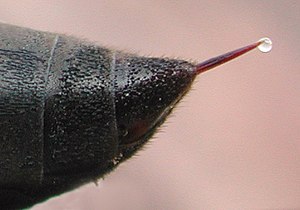
Wasp stinger with a droplet of venom Venom or zootoxin is a type of toxin produced by an animal that is actively delivered through a wound by means of a bite, sting, or similar action.[1][2][3] The toxin is delivered through a specially evolved venom apparatus, such as fangs or a stinger, in a process called envenomation.[2] Venom is often distinguished from poison, which is a toxin that is passively delivered by being ingested, inhaled, or absorbed through the skin,[4] and toxungen, which is actively transferred to the external surface of another animal via a physical delivery mechanism.[5]
Venom has evolved in terrestrial and marine environments and in a wide variety of animals: both predators and prey, and both vertebrates and invertebrates. Venoms kill through the action of at least four major classes of toxin, namely necrotoxins and cytotoxins, which kill cells; neurotoxins, which affect nervous systems; myotoxins, which damage muscles; and haemotoxins, which disrupt blood clotting. Venomous animals cause tens of thousands of human deaths per year.
Venoms are often complex mixtures of toxins of differing types. Toxins from venom are used to treat a wide range of medical conditions including thrombosis, arthritis, and some cancers. Studies in venomics are investigating the potential use of venom toxins for many other conditions.
Evolution[edit]
The use of venom across a wide variety of taxa is an example of convergent evolution. It is difficult to conclude exactly how this trait came to be so intensely widespread and diversified. The multigene families that encode the toxins of venomous animals are actively selected, creating more diverse toxins with specific functions. Venoms adapt to their environment and victims, evolving to become maximally efficient on a predator's particular prey (particularly the precise ion channels within the prey). Consequently, venoms become specialized to an animal's standard diet.[6]
Mechanisms[edit]

Phospholipase A2, an enzyme in bee venom, releases fatty acids, affecting calcium signalling. Venoms cause their biological effects via the many toxins that they contain; some venoms are complex mixtures of toxins of differing types. Major classes of toxin in venoms include:[7]
- Necrotoxins, which cause necrosis (i.e., death) in the cells they encounter. The venoms of vipers and bees contain phospholipases; viper venoms often also contain trypsin-like serine proteases.[8]
- Neurotoxins, which primarily affect the nervous systems of animals, such as ion channel toxins. These are found in many venomous taxa, including black widow spiders, scorpions, box jellyfish, cone snails, centipedes and blue-ringed octopuses.[9]
- Myotoxins, which damage muscles by binding to a receptor. These small, basic peptides are found in snake (such as rattlesnake) and lizard venoms.[10][11][12][13]
- Cytotoxins, which kill individual cells and are found in the apitoxin of honey bees and the venom of black widow spiders.[14][15]
Taxonomic range[edit]
Venom is widely distributed taxonomically, being found in both invertebrates and vertebrates, in aquatic and terrestrial animals, and among both predators and prey. The major groups of venomous animals are described below.
Arthropods[edit]
Venomous arthropods include spiders, which use fangs on their chelicerae to inject venom, and centipedes, which use forcipules — modified legs — to deliver venom, while scorpions and stinging insects inject venom with a sting. In bees and wasps, the stinger is a modified ovipositor (egg-laying device). In Polistes fuscatus, the female continuously releases a venom that contains a sex pheromone that induces copulatory behavior in males.[16] In wasps such as Polistes exclamans, venom is used as an alarm pheromone, coordinating a response from the nest and attracting nearby wasps to attack the predator.[17] In some species, such as Parischnogaster striatula, venom is applied all over the body as an antimicrobial protection.[18]
Many caterpillars have defensive venom glands associated with specialized bristles on the body called urticating hairs. These are usually merely irritating, but those of the Lonomia moth can be fatal to humans.[19]
Bees synthesize and employ an acidic venom (apitoxin) to defend their hives and food stores, whereas wasps use a chemically different venom to paralyse prey, so their prey remains alive to provision the food chambers of their young. The use of venom is much more widespread than just these examples; many other insects, such as true bugs and many ants, also produce venom.[20] The ant species Polyrhachis dives uses venom topically for the sterilisation of pathogens.[21]
Other invertebrates[edit]

The fingernail-sized box jellyfish Malo kingi has among the most dangerous venom of any animal, causing Irukandji syndrome — severe pain, vomiting, and rapid rise in blood pressure There are venomous invertebrates in several phyla, including jellyfish such as the dangerous box jellyfish,[22] the Portuguese man-of-war (a siphonophore) and sea anemones among the Cnidaria,[23] sea urchins among the Echinodermata,[24] and cone snails[25] and cephalopods, including octopuses, among the Molluscs.[26]
Vertebrates[edit]
Fish[edit]
Venom is found in some 200 cartilaginous fishes, including stingrays, sharks, and chimaeras; the catfishes (about 1000 venomous species); and 11 clades of spiny-rayed fishes (Acanthomorpha), containing the scorpionfishes (over 300 species), stonefishes (over 80 species), gurnard perches, blennies, rabbitfishes, surgeonfishes, some velvetfishes, some toadfishes, coral crouchers, red velvetfishes, scats, rockfishes, deepwater scorpionfishes, waspfishes, weevers, and stargazers.[27]
Amphibians[edit]
Some salamanders can extrude sharp venom-tipped ribs.[28][29] Two frog species in Brazil have tiny spines around the crown of their skulls which, on impact, deliver venom into their targets.[30]
Reptiles[edit]
The venom of the prairie rattlesnake, Crotalus viridis (left), includes metalloproteinases (example on the right) which help digest prey before eating.Some 450 species of snake are venomous.[27] Snake venom is produced by glands below the eye (the mandibular glands) and delivered to the target through tubular or channeled fangs. Snake venoms contain a variety of peptide toxins, including proteases, which hydrolyze protein peptide bonds; nucleases, which hydrolyze the phosphodiester bonds of DNA; and neurotoxins, which disrupt signalling in the nervous system.[31] Snake venom causes symptoms including pain, swelling, tissue necrosis, low blood pressure, convulsions, haemorrhage (varying by species of snake), respiratory paralysis, kidney failure, coma, and death.[32] Snake venom may have originated with duplication of genes that had been expressed in the salivary glands of ancestors.[33][34]
Venom is found in a few other reptiles such as the Mexican beaded lizard,[35] the gila monster,[36] and some monitor lizards, including the Komodo dragon.[37] Mass spectrometry showed that the mixture of proteins present in their venom is as complex as the mixture of proteins found in snake venom.[37][38] Some lizards possess a venom gland; they form a hypothetical clade, Toxicofera, containing the suborders Serpentes and Iguania and the families Varanidae, Anguidae, and Helodermatidae.[39]
Mammals[edit]
Euchambersia, an extinct genus of therocephalians, is hypothesized to have had venom glands attached to its canine teeth.[40]
A few species of living mammals are venomous, including solenodons, shrews, vampire bats, male platypuses, and slow lorises.[27][41] Shrews have venomous saliva and most likely evolved their trait similarly to snakes.[42] The presence of tarsal spurs akin to those of the platypus in many non-therian Mammaliaformes groups suggests that venom was an ancestral characteristic among mammals.[43]
Extensive research on platypuses shows that their toxin was initially formed from gene duplication, but data provides evidence that the further evolution of platypus venom does not rely as much on gene duplication as was once thought.[44] Modified sweat glands are what evolved into platypus venom glands. Although it is proven that reptile and platypus venom have independently evolved, it is thought that there are certain protein structures that are favored to evolve into toxic molecules. This provides more evidence of why venom has become a homoplastic trait and why very different animals have convergently evolved.[13]
Venom and humans[edit]
Envenomation resulted in 57,000 human deaths in 2013, down from 76,000 deaths in 1990.[45] Venoms, found in over 173,000 species, have potential to treat a wide range of diseases, explored in over 5,000 scientific papers.[36]
In medicine, snake venom proteins are used to treat conditions including thrombosis, arthritis, and some cancers.[46][47] Gila monster venom contains exenatide, used to treat type 2 diabetes.[36] Solenopsins extracted from fire ant venom has demonstrated biomedical applications, ranging from cancer treatment to psoriasis.[48][49] A branch of science, venomics, has been established to study the proteins associated with venom and how individual components of venom can be used for pharmaceutical means.[50]
Resistance[edit]
The California ground squirrel is resistant to the Northern Pacific rattlesnake's powerful venom.Venom is used as a trophic weapon by many predator species. The coevolution between predators and prey is the driving force of venom resistance, which has evolved multiple times throughout the animal kingdom.[51] The coevolution between venomous predators and venom-resistant prey has been described as a chemical arms race.[52] Predator/prey pairs are expected to coevolve over long periods of time.[53] As the predator capitalizes on susceptible individuals, the surviving individuals are limited to those able to evade predation.[54] Resistance typically increases over time as the predator becomes increasingly unable to subdue resistant prey.[55] The cost of developing venom resistance is high for both predator and prey.[56] The payoff for the cost of physiological resistance is an increased chance of survival for prey, but it allows predators to expand into underutilised trophic niches.[57]
The California ground squirrel has varying degrees of resistance to the venom of the Northern Pacific rattlesnake.[58] The resistance involves toxin scavenging and depends on the population. Where rattlesnake populations are denser, squirrel resistance is higher.[59] Rattlesnakes have responded locally by increasing the effectiveness of their venom.[60]
The kingsnakes of the Americas are constrictors that prey on many venomous snakes.[61] They have evolved resistance which does not vary with age or exposure.[55] They are immune to the venom of snakes in their immediate environment, like copperheads, cottonmouths, and North American rattlesnakes, but not to the venom of, for example, king cobras or black mambas.[62]
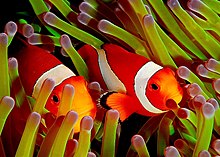
Ocellaris clownfish always live among venomous sea anemone tentacles and are resistant to the venom. Among marine animals, eels are resistant to sea snake venoms, which contain complex mixtures of neurotoxins, myotoxins, and nephrotoxins, varying according to species.[63][64] Eels are especially resistant to the venom of sea snakes that specialise in feeding on them, implying coevolution; non-prey fishes have little resistance to sea snake venom.[65]
Clownfish always live among the tentacles of venomous sea anemones (an obligatory symbiosis for the fish),[66] and are resistant to their venom.[67][68] Only 10 known species of anemones are hosts to clownfish and only certain pairs of anemones and clownfish are compatible.[69][70] All sea anemones produce venoms delivered through discharging nematocysts and mucous secretions. The toxins are composed of peptides and proteins. They are used to acquire prey and to deter predators by causing pain, loss of muscular coordination, and tissue damage. Clownfish have a protective mucus that acts as a chemical camouflage or macromolecular mimicry preventing "not self" recognition by the sea anemone and nematocyst discharge.[71][72][73] Clownfish may acclimate their mucus to resemble that of a specific species of sea anemone.[73]
See also[edit]
References[edit]
- ^ "venom" at Dorland's Medical Dictionary
- ^ a b Gupta, Ramesh C. (24 March 2017). Reproductive and developmental toxicology. Saint Louis. pp. 963–972. ISBN 978-0-12-804240-3. OCLC 980850276.
{{cite book}}: CS1 maint: location missing publisher (link) - ^ Chippaux, JP; Goyffon, M (2006). "[Venomous and poisonous animals--I. Overview]". Médecine Tropicale (in French). 66 (3): 215–20. ISSN 0025-682X. PMID 16924809.
- ^ "Poison vs. Venom". Australian Academy of Science. 3 November 2017. Retrieved 17 April 2022.
- ^ Nelsen, D. R., Nisani, Z., Cooper, A. M., Fox, G. A., Gren, E. C., Corbit, A. G., & Hayes, W. K. (2014). "Poisons, toxungens, and venoms: redefining and classifying toxic biological secretions and the organisms that employ them". Biological Reviews, 89(2), 450-465. doi:10.1111/brv.12062. PMID: 24102715.
- ^ Kordiš, D.; Gubenšek, F. (2000). "Adaptive evolution of animal toxin multigene families". Gene. 261 (1): 43–52. doi:10.1016/s0378-1119(00)00490-x. PMID 11164036.
- ^ Harris, J. B. (September 2004). "Animal poisons and the nervous system: what the neurologist needs to know". Journal of Neurology, Neurosurgery & Psychiatry. 75 (suppl_3): iii40–iii46. doi:10.1136/jnnp.2004.045724. PMC 1765666. PMID 15316044.
- ^ Raffray, M.; Cohen, G. M. (1997). "Apoptosis and necrosis in toxicology: a continuum or distinct modes of cell death?". Pharmacology & Therapeutics. 75 (3): 153–177.
Indiana Jones V2
Indiana Jones version 2 theme by Windrider
Download: IndianaJonesV2.p3t
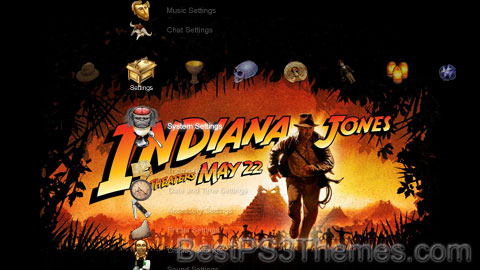
(4 backgrounds)
P3T Unpacker v0.12
Copyright (c) 2007. Anoop MenonThis program unpacks Playstation 3 Theme files (.p3t) so that you can touch-up an existing theme to your likings or use a certain wallpaper from it (as many themes have multiple). But remember, if you use content from another theme and release it, be sure to give credit!
Download for Windows: p3textractor.zip
Instructions:
Download p3textractor.zip from above. Extract the files to a folder with a program such as WinZip or WinRAR. Now there are multiple ways to extract the theme.
The first way is to simply open the p3t file with p3textractor.exe. If you don’t know how to do this, right click the p3t file and select Open With. Alternatively, open the p3t file and it will ask you to select a program to open with. Click Browse and find p3textractor.exe from where you previously extracted it to. It will open CMD and extract the theme to extracted.[filename]. After that, all you need to do for any future p3t files is open them and it will extract.
The second way is very simple. Just drag the p3t file to p3textractor.exe. It will open CMD and extract the theme to extracted.[filename].
For the third way, first put the p3t file you want to extract into the same folder as p3textractor.exe. Open CMD and browse to the folder with p3extractor.exe. Enter the following:
p3textractor filename.p3t [destination path]Replace filename with the name of the p3t file, and replace [destination path] with the name of the folder you want the files to be extracted to. A destination path is not required. By default it will extract to extracted.filename.inFAMOUS
Vanessa Anne Hudgens PS3
Vanessa Anne Hudgens PS3 theme by ZHero
Download: VanessaAnneHudgensPS3.p3t

(9 backgrounds)
P3T Unpacker v0.12
Copyright (c) 2007. Anoop MenonThis program unpacks Playstation 3 Theme files (.p3t) so that you can touch-up an existing theme to your likings or use a certain wallpaper from it (as many themes have multiple). But remember, if you use content from another theme and release it, be sure to give credit!
Download for Windows: p3textractor.zip
Instructions:
Download p3textractor.zip from above. Extract the files to a folder with a program such as WinZip or WinRAR. Now there are multiple ways to extract the theme.
The first way is to simply open the p3t file with p3textractor.exe. If you don’t know how to do this, right click the p3t file and select Open With. Alternatively, open the p3t file and it will ask you to select a program to open with. Click Browse and find p3textractor.exe from where you previously extracted it to. It will open CMD and extract the theme to extracted.[filename]. After that, all you need to do for any future p3t files is open them and it will extract.
The second way is very simple. Just drag the p3t file to p3textractor.exe. It will open CMD and extract the theme to extracted.[filename].
For the third way, first put the p3t file you want to extract into the same folder as p3textractor.exe. Open CMD and browse to the folder with p3extractor.exe. Enter the following:
p3textractor filename.p3t [destination path]Replace filename with the name of the p3t file, and replace [destination path] with the name of the folder you want the files to be extracted to. A destination path is not required. By default it will extract to extracted.filename.PS3 Modern
PS3 Modern theme by Speud
Download: PS3Modern.p3t
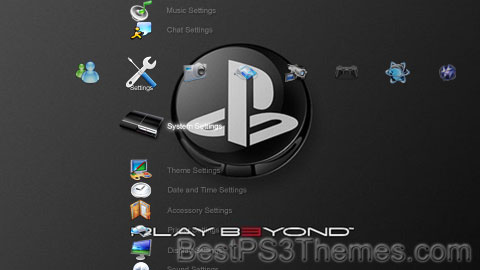
(3 backgrounds)
P3T Unpacker v0.12
Copyright (c) 2007. Anoop MenonThis program unpacks Playstation 3 Theme files (.p3t) so that you can touch-up an existing theme to your likings or use a certain wallpaper from it (as many themes have multiple). But remember, if you use content from another theme and release it, be sure to give credit!
Download for Windows: p3textractor.zip
Instructions:
Download p3textractor.zip from above. Extract the files to a folder with a program such as WinZip or WinRAR. Now there are multiple ways to extract the theme.
The first way is to simply open the p3t file with p3textractor.exe. If you don’t know how to do this, right click the p3t file and select Open With. Alternatively, open the p3t file and it will ask you to select a program to open with. Click Browse and find p3textractor.exe from where you previously extracted it to. It will open CMD and extract the theme to extracted.[filename]. After that, all you need to do for any future p3t files is open them and it will extract.
The second way is very simple. Just drag the p3t file to p3textractor.exe. It will open CMD and extract the theme to extracted.[filename].
For the third way, first put the p3t file you want to extract into the same folder as p3textractor.exe. Open CMD and browse to the folder with p3extractor.exe. Enter the following:
p3textractor filename.p3t [destination path]Replace filename with the name of the p3t file, and replace [destination path] with the name of the folder you want the files to be extracted to. A destination path is not required. By default it will extract to extracted.filename.Batgirl
Batgirl theme by myownscars
Download: Batgirl.p3t

(2 backgrounds)
Batgirl  Barbara Gordon, Cassandra Cain, and Stephanie Brown on a variant cover for Batgirls #1 (February 2022) by Alex Garner.
Barbara Gordon, Cassandra Cain, and Stephanie Brown on a variant cover for Batgirls #1 (February 2022) by Alex Garner.Publisher DC Comics First appearance Batman #139 (April 1961) Created by Bill Finger (writer)
Sheldon Moldoff (art)Characters Batgirl 
Batgirl #1 (April 2000)
featuring the Cassandra Cain version of the character,
art by Damion ScottSeries publication information Publisher DC Comics Schedule Monthly Format List- (vol. 1, 3–5, Batgirls)
Ongoing series - (vol. 2)
Limited series
Genre Publication date List- (vol. 1)
April 2000 – April 2006 - (vol. 2)
September 2008 – February 2009 - (vol. 3)
October 2009 – October 2011 - (vol. 4)
November 2011 – July 2016 - (vol. 5)
September 2016 – December 2020 - (Batgirls)
February 2022 – August 2023
Number of issues List- (vol. 1): 73 + 1 Annual
- (vol. 2): 6
- (vol. 3): 24
- (vol. 4): 53 (#1–52, 0) + 3 Annuals
- (vol. 5): 50 + 2 Annuals and a DC Rebirth one-shot
- (Batgirls): 19 + 1 Annual
Main character(s) List- (vol. 1–2)
- (vol. 3)
- (vol. 4, 5)
- (Batgirls)
- Cassandra Cain
- Stephanie Brown
Creative team Writer(s) List- (vol. 1)
- (vol. 2)
- (vol. 3)
- (vol. 4)
- (vol. 5)
- (Batgirls)
Penciller(s) List- (vol. 1)
- Damion Scott
- Adrian Sibar
- Rick Leonardi
- Ale Garza
- Pop Mhan
- (vol. 2)
- (vol. 3)
- Lee Garbett
- Pere Perez
- Dustin Nguyen
- (vol. 4)
- Ardian Syaf
- Ed Benes
- Daniel Sampere
- Fernando Pasarin
- Babs Tarr
- (vol. 5)
- Rafael Albuquerque
- Christian Wildgoose
- Paul Pelletier
- (Batgirls)
Inker(s) List- (vol. 1)
- Robert Campanella
- Andy Owens
- Jesse Delperdang
- (vol. 3)
- Trevor Scott
- Dereck Fridolfs
- (vol. 4)
- Vicente Cifuentes
- Jonathan Glapion
Colorist(s) List- (vol. 1)
- Jason Wright
- (vol. 2)
- Nathan Eyring
- (vol. 3)
- Guy Major
- (vol. 4)(vol. 5)
- Ulises Arreola
- Kevin Senft
- Maris Wicks
Batgirl is the name of several fictional superheroines appearing in American comic books published by DC Comics, depicted as female counterparts and allies to the superhero Batman. The character Betty Kane was introduced into publication in 1961 by Bill Finger and Sheldon Moldoff as Bat-Girl, and was replaced in 1967 by Barbara Gordon, who became the iconic Batgirl.[1][2] The character debuted in Detective Comics #359 (January 1967) by writer Gardner Fox and artist Carmine Infantino, introduced as the niece/adoptive daughter of police commissioner James Gordon.
Batgirl operates in Gotham City, allying herself with Batman and the original Robin, Dick Grayson, along with other masked vigilantes. The character appeared regularly in Detective Comics, Batman Family, and several other books produced by DC until 1988. That year, Barbara Gordon appeared in Barbara Kesel's Batgirl Special #1, in which she retires from crime-fighting. She subsequently appeared in Alan Moore's graphic novel Batman: The Killing Joke where, in her civilian identity, she is shot by the Joker and left paraplegic. Although she is reimagined as the computer expert and information broker Oracle by editor Kim Yale and writer John Ostrander the following year, her paralysis sparked debate about the portrayal of women in comics, particularly violence depicted toward female characters.
In the 1999 storyline "No Man's Land", the character Helena Bertinelli, known as Huntress, briefly assumes the role of Batgirl until she is stripped of the identity by Batman for violating his stringent codes. Within the same storyline, the character Cassandra Cain is introduced. Cain is written as the daughter of assassins David Cain and Lady Shiva and takes the mantle of Batgirl under the guidance of Batman and Oracle. In 2000, she became the first Batgirl to star in an eponymous monthly comic book series, in addition to becoming one of the most prominent characters of Asian descent to appear in American comics. The series was canceled in 2006, at which point during the company-wide storyline "One Year Later", she is established as a villain and head of the League of Assassins. After receiving harsh feedback from readership, she is later restored to her original conception. However, the character Stephanie Brown, originally known as Spoiler and later Robin, succeeds her as Batgirl after Cassandra Cain abandons the role.
Stephanie Brown became the featured character of the Batgirl series from 2009 to 2011, prior to DC's The New 52 relaunch, which established Barbara Gordon recovering from her paralysis following a surgical procedure and starring as the title character of Batgirl once again. Barbara later returned to the Oracle role with Infinite Frontier in 2020, and currently operates as both Batgirl and Oracle, with Cassandra and Stephanie also serving as Batgirls. The Barbara Gordon version of Batgirl has been adapted into various media relating to the Batman franchise, including television, film, animation, video games, and other merchandise. Dan DiDio, co-publisher of DC Comics, expressed that Barbara is the best-known version of the character.
Publication history[edit]
 This article may contain an excessive amount of intricate detail that may interest only a particular audience. (May 2017)
This article may contain an excessive amount of intricate detail that may interest only a particular audience. (May 2017)Detective Comics, Batman Family, and other appearances (1961–1988)[edit]
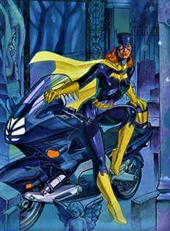
Barbara Gordon as Batgirl: art by Brian Stelfreeze Following the accusations of a homoerotic subtext in the depiction of the relationship between Batman and Robin as described in Fredric Wertham's book Seduction of the Innocent (1954), a female character, Kathy Kane the Batwoman, appeared in 1956 as a love interest for Batman.[3] In 1961, DC Comics introduced a second female character as a love interest for Robin.[3] Betty Kane as "Bat-Girl" arrived as the niece of, and Robin-like sidekick to, Batwoman, first appearing in Batman #139 (April 1961).[4] The creation of the Batman family, which included Batman and Batwoman depicted as parents, Robin and Bat-Girl depicted as their children, the extraterrestrial imp Bat-Mite and the "family pet" Ace the Bat-Hound, caused the Batman-related comic books to take "a wrong turn, switching from superheroes to situational comedy".[3]
DC Comics abandoned these characters in 1964 when newly appointed Batman-editor Julius Schwartz judged them too silly and therefore inappropriate.[5] Schwartz had asserted that these characters should be removed, considering the Batman related comic books had steadily declined in sales, and restored the Batman mythology to its original conception of heroic vigilantism.[3] Bat-Girl, along with other characters in the Batman Family, were retconned out of existence following the 1985 limited series Crisis on Infinite Earths.[6] However, even though Bat-Girl did not exist in the Post-Crisis continuity, a modified version of the character, Mary Elizabeth "Bette" Kane, introduced as the superhero Flamebird, continues to appear in DC Comics publications.[7]
Schwartz stated that he had been asked to develop a new female character to attract a female viewership to the Batman television series of the 1960s.[8] Executive producer William Dozier suggested that the new character would be the daughter of Gotham City's Police Commissioner James Gordon, and that she would adopt the identity of Batgirl.[9] When Dozier and producer Howie Horowitz saw rough concept artwork of the new Batgirl by artist Carmine Infantino during a visit to DC offices, they optioned the character in a bid to help sell a third season to the ABC television network. Infantino reflected on the creation of Batgirl, stating "Bob Kane had had a Bat-Girl for about three stories in the ’50s but she had nothing to do with a bat. She was like a pesky girl version of Robin. I knew we could do a lot better, so Julie and I came up with the real Batgirl, who was so popular she almost got her own TV show."[10] Yvonne Craig portrayed the character in the show's third season.[11] Barbara Gordon and her alter ego Batgirl debuted in Detective Comics #359, "The Million Dollar Debut of Batgirl" (1967). In the debut story, while driving to a costume ball dressed as a female version of Batman, Barbara Gordon intervenes in a kidnapping attempt on Bruce Wayne by the supervillain Killer Moth, attracting Batman's attention and leading to a crimefighting career. Although Batman insists she give up crimefighting because of her gender, Batgirl disregards his objections.[12]
In her civilian identity, Dr. Barbara Gordon is a career woman with a doctorate in library science, as well as being head of the Gotham City Public Library, "presumably one of the largest public libraries in the DC Comics version of reality."[13] She was given a regular back-up slot in Detective Comics starting with issue #384 (February 1969), alternating issues with Robin until issue #404, after which she had the back-up slot to herself. Frank Robbins wrote nearly all of these back-ups, which were penciled first by Gil Kane and later by Don Heck.[9] Barbara Gordon's Batgirl exceeded the earlier Bat-Girl and Batwoman characters in popularity, and readers requested for her to appear in other titles. Although some readers requested that Batwoman also continue to appear in publication, DC responded to the fan-based acclaim and criticism of the new character in an open letter in Detective Comics #417 (1971),[14] stating: "I'd like to say a few words about the reaction some readers have to Batgirl. These are readers who remember Batwoman and the other Bat-girls from years back ... They were there because romance seemed to be needed in Batman's life. But thanks to the big change and a foresighted editor, these hapless females are gone for good. In their place stands a girl who is a capable crime-fighter, a far cry from Batwoman who constantly had to be rescued [by] Batman."[5]
Batgirl continued to appear in DC Comics publications throughout the late 1960s and 1970s as a supporting character in Detective Comics, in addition to guest appearances in various titles such as Justice League of America,[15] World's Finest Comics,[16] The Brave and the Bold,[17] Adventure Comics,[18] and Superman.[19] In the early-1970s, Batgirl reveals her secret identity to her father (who had already discovered it on his own) and serves as a member of the United States House of Representatives. She moves to Washington, D.C., intending to give up her career as Batgirl, and in June 1972 appeared in a story entitled "Batgirl's Last Case."[20] Julius Schwartz brought her back a year later in Superman #268 (1973)[19] in which she has a blind date with Clark Kent, establishing their friendship, and fights alongside Superman. Batgirl and Superman team up twice more, in Superman #279 and DC Comics Presents #19. Batgirl also guest-starred in other Superman related titles, such as #453 of Adventure Comics and in Superman Family #171, where she teams up with Supergirl.
The character is given a starring role in DC's Batman Family comic book which debuted in 1975.[21] The original Robin, Dick Grayson, became her partner in the series, with the two frequently referred to as the "Dynamite Duo: Batgirl & Robin". Batgirl meets Batwoman in Batman Family #10, when the retired superhero briefly returns to crimefighting (before the Bronze Tiger murders Kane). The two fight Killer Moth and the Cavalier, and learn each other's secret identities. Batwoman retires once again at the conclusion of the story, leaving Batgirl to continue crimefighting.[22] Although this series ended after three years of publication,[23] Batgirl continued to appear in back-up stories published in Detective Comics through issue #519 (October 1982).
Crisis on Infinite Earths, a limited series published in 1985, was written to reduce the complex history of DC Comics to a single continuity. Although Batgirl is a featured character, her role is relatively small—she delivers Supergirl's eulogy in issue #7 of the 12-part series.[24] The conclusion of Crisis on Infinite Earths changed DC Universe continuity in many ways. Following the reboot, Barbara Gordon is born to Roger and Thelma Gordon, and she is Jim Gordon's niece and adopted daughter in post - crisis continuity. Post-Crisis, Supergirl does not arrive on Earth until after Gordon has established herself as Oracle, and many of the adventures she shared with Batgirl are retroactively described as having been experienced by Power Girl. In Secret Origins (vol. 2) #20 (1987),[25] Barbara Gordon's origin is rebooted by author Barbara Randal. Within the storyline, Gordon recounts the series of events that led to her career as Batgirl, including her first encounter with Batman as a child, studying martial arts under the tutelage of a sensei, memorizing maps and blueprints of the city, excelling in academics to skip grades, and pushing herself to become a star athlete.
Batgirl Special #1 and Batman: The Killing Joke (1988)[edit]
DC officially retired the hero in the one-shot comic Batgirl Special #1 (July 1988), written by Barbara Kesel.[26] Later that year, she appears in Alan Moore's Batman: The Killing Joke. In this graphic novel, the Joker shoots and paralyzes Barbara Gordon in an attempt to drive her father insane, thereby proving to Batman that anyone can lose their minds after having "one bad day".[27] She is deployed as a plot device to cement the Joker's vendetta against Commissioner Gordon and Batman. In 2006, during an interview with Wizard, Moore expressed regret over his treatment of the character, calling it "shallow and ill-conceived".[28] He stated prior to writing the graphic novel, "I asked DC if they had any problem with me crippling Barbara Gordon—who was Batgirl at the time—and if I remember, I spoke to Len Wein, who was our editor on the project", and following a discussion with then-Executive Editorial Director Dick Giordano, "Len got back onto the phone and said, ‘Yeah, okay, cripple the bitch.'"[28]
Although there has been speculation as to whether or not editors at DC specifically intended to have the character's paralysis become permanent, Brian Cronin, author of Was Superman A Spy?: And Other Comic Book Legends Revealed (2009) noted that DC had hired Barbara Kesel to write the Batgirl Special specifically to retire the character and set her in place for The Killing Joke.[29] Gail Simone included the character's paralysis in a list of "major female characters that had been killed, mutilated, and depowered", dubbing the phenomenon "Women in Refrigerators" in reference to a 1994 Green Lantern story where the title character discovers his girlfriend's mutilated body in his refrigerator.[30] Following the release of the graphic novel, comic book editor and writer Kim Yale discussed how distasteful she found the treatment of Barbara Gordon with her husband, fellow comic writer John Ostrander. Rather than allow the character to fall into obscurity, the two decided to revive her as a character living with a disability—the information broker called the Oracle.[31]
"No Man's Land" (1999)[edit]
Eleven years after the editorial retirement of Barbara Gordon as Batgirl, a new version of the character was introduced in Batman: Shadow of the Bat #83 during the multi-title story arc "No Man's Land" (1999).[32] In Batman: Legends of the Dark Knight #120 (1999), the new Batgirl is revealed to be Helena Bertinelli, an established DC comics superhero alternatively known as the Huntress.[33] Bertinelli is eventually forced to abandon the mantle by Batgirl.[34] No Man's Land also marks the introduction of Cassandra Cain in Batman #567 (1999).[35] Depicted as a martial arts child prodigy, Cassandra Cain is written as a young woman of partly Asian descent who succeeds Helena Bertinelli as Batgirl, with the approval of both Batman and the Oracle.
Batgirl and other appearances (2000–2011)[edit]
The first Batgirl monthly comic was published in 2000, with Cassandra Cain as the title character. Raised by assassin David Cain, Cassandra Cain was not taught spoken language, but instead was taught to "read" physical movement. Subsequently, Cain's only form of communication was body language.[36] The parts of the character's brain normally used for speech were trained so Cain could read other people's body language and predict, with uncanny accuracy, their next move. This also caused her brain to develop learning functions different from most, a form of dyslexia that hampers her abilities to read and write.
Despite Cain's disability, author Andersen Gabrych describes the character's unique form of language as the key factor in what makes Cain an excellent detective; the ability to walk into a room and "know" something is wrong based on body language.[36] During "Silent Running", the first arc of the Batgirl comic book series, Cassandra Cain encounters a psychic who "reprograms" her brain, enabling her to comprehend verbal language, while simultaneously losing the ability to predict movements.[37] This issue is resolved during the second arc of the series, "A Knight Alone", when Batgirl encounters the assassin Lady Shiva who agrees to teach her how to predict movement once again.[38] Six years after its debut, DC Comics cancelled the Batgirl comic book series with issue #73 (2006), ending with Cain relinquishing her role as Batgirl.[39]
When DC Comics continuity skipped forward one year after the events of the limited series Infinite Crisis, Cassandra Cain is revived as the leader of the League of Assassins, having abandoned her previous characterization as an altruist. The character's progression from hero to villain angered some of her fans and was accompanied by heavy criticism.[40] Cain reprised her role as Batgirl in the "Titans East" (2007) storyline of Teen Titans,[41] where it was discovered that she had been influenced by a mind-altering drug administered by supervillain Deathstroke the Terminator. Following the conclusion of the storyline, DC Comics has restored Cain's original characterization as a superhero and the character has been given a supporting role in the comic book series Batman and the Outsiders.
Following the events of Batman's disappearance, Cassandra, acting under her mentor's orders in the event of his death, handed over the Batgirl mantle to Stephanie Brown, the former Spoiler and the fourth Robin.[42] After declining an offer from Tim Drake to reclaim the Batgirl mantle from Stephanie,[43] Cassandra rejoined the Batman Family under the new identity of the Blackbat.[44] She currently acts as the Hong Kong representative of Batman Inc.
Stephanie Brown does take the mantle of Batgirl after Cassandra Cain gives Brown her costume under Batman's orders.[42] Eventually, Barbara Gordon approves of Brown as her newest successor — and she gives Brown her own Batgirl costume and becomes her mentor for a period. Brown is the fourth in-continuity Batgirl and the second Batgirl to star in her own ongoing Batgirl comic book series.
The New 52: Batgirl, Birds of Prey, and other appearances (2011–2016)[edit]
In September 2011, following the company-wide relaunch, Barbara Gordon stars in a new Batgirl series—one of The New 52 titles featuring the company's most iconic characters. The conclusion of the limited series Flashpoint (2011) establishes a new continuity within the DC Universe, with all characters regressing to an earlier age and stage in their careers, while remaining in a modern timeline. DC Senior VP of Sales, Bob Wayne, explained that with each of their titles reverting to issue #1, "our creative teams have the ability to take a more modern approach—not only with each character, but with how the characters interact with one another and the universe as a whole, and focus on the earlier part of the careers of each of our iconic characters."[45] Barbara Gordon is biological daughter of James Gordon and Barbara Eileen Gordon in this continuity. Wayne also stated that "The Killing Joke still happened and she was Oracle. Now she will go through physical rehabilitation and become a more seasoned and nuanced character because she had these incredible and diverse experiences.[45] Dan DiDio, Co-Publisher of DC Comics explained the decision by stating that "she'll always be the most recognizable [Batgirl]."[46] Series writer Gai
Minimal Graffiti
Minimal Graffiti theme by Sarah_J
Download: MinimalGraffiti.p3t

(3 backgrounds)
P3T Unpacker v0.12
Copyright (c) 2007. Anoop MenonThis program unpacks Playstation 3 Theme files (.p3t) so that you can touch-up an existing theme to your likings or use a certain wallpaper from it (as many themes have multiple). But remember, if you use content from another theme and release it, be sure to give credit!
Download for Windows: p3textractor.zip
Instructions:
Download p3textractor.zip from above. Extract the files to a folder with a program such as WinZip or WinRAR. Now there are multiple ways to extract the theme.
The first way is to simply open the p3t file with p3textractor.exe. If you don’t know how to do this, right click the p3t file and select Open With. Alternatively, open the p3t file and it will ask you to select a program to open with. Click Browse and find p3textractor.exe from where you previously extracted it to. It will open CMD and extract the theme to extracted.[filename]. After that, all you need to do for any future p3t files is open them and it will extract.
The second way is very simple. Just drag the p3t file to p3textractor.exe. It will open CMD and extract the theme to extracted.[filename].
For the third way, first put the p3t file you want to extract into the same folder as p3textractor.exe. Open CMD and browse to the folder with p3extractor.exe. Enter the following:
p3textractor filename.p3t [destination path]Replace filename with the name of the p3t file, and replace [destination path] with the name of the folder you want the files to be extracted to. A destination path is not required. By default it will extract to extracted.filename.The Dark Knight 3.0
The Dark Knight 3.0 theme by Daytripper
Download: DarkKnight3.p3t

(1 background)
P3T Unpacker v0.12
Copyright (c) 2007. Anoop MenonThis program unpacks Playstation 3 Theme files (.p3t) so that you can touch-up an existing theme to your likings or use a certain wallpaper from it (as many themes have multiple). But remember, if you use content from another theme and release it, be sure to give credit!
Download for Windows: p3textractor.zip
Instructions:
Download p3textractor.zip from above. Extract the files to a folder with a program such as WinZip or WinRAR. Now there are multiple ways to extract the theme.
The first way is to simply open the p3t file with p3textractor.exe. If you don’t know how to do this, right click the p3t file and select Open With. Alternatively, open the p3t file and it will ask you to select a program to open with. Click Browse and find p3textractor.exe from where you previously extracted it to. It will open CMD and extract the theme to extracted.[filename]. After that, all you need to do for any future p3t files is open them and it will extract.
The second way is very simple. Just drag the p3t file to p3textractor.exe. It will open CMD and extract the theme to extracted.[filename].
For the third way, first put the p3t file you want to extract into the same folder as p3textractor.exe. Open CMD and browse to the folder with p3extractor.exe. Enter the following:
p3textractor filename.p3t [destination path]Replace filename with the name of the p3t file, and replace [destination path] with the name of the folder you want the files to be extracted to. A destination path is not required. By default it will extract to extracted.filename.Clear2
Clear2 theme by Xi2Wiked
Download: Clear2.p3t

(2 backgrounds)
P3T Unpacker v0.12
Copyright (c) 2007. Anoop MenonThis program unpacks Playstation 3 Theme files (.p3t) so that you can touch-up an existing theme to your likings or use a certain wallpaper from it (as many themes have multiple). But remember, if you use content from another theme and release it, be sure to give credit!
Download for Windows: p3textractor.zip
Instructions:
Download p3textractor.zip from above. Extract the files to a folder with a program such as WinZip or WinRAR. Now there are multiple ways to extract the theme.
The first way is to simply open the p3t file with p3textractor.exe. If you don’t know how to do this, right click the p3t file and select Open With. Alternatively, open the p3t file and it will ask you to select a program to open with. Click Browse and find p3textractor.exe from where you previously extracted it to. It will open CMD and extract the theme to extracted.[filename]. After that, all you need to do for any future p3t files is open them and it will extract.
The second way is very simple. Just drag the p3t file to p3textractor.exe. It will open CMD and extract the theme to extracted.[filename].
For the third way, first put the p3t file you want to extract into the same folder as p3textractor.exe. Open CMD and browse to the folder with p3extractor.exe. Enter the following:
p3textractor filename.p3t [destination path]Replace filename with the name of the p3t file, and replace [destination path] with the name of the folder you want the files to be extracted to. A destination path is not required. By default it will extract to extracted.filename. - (vol. 1, 3–5, Batgirls)
